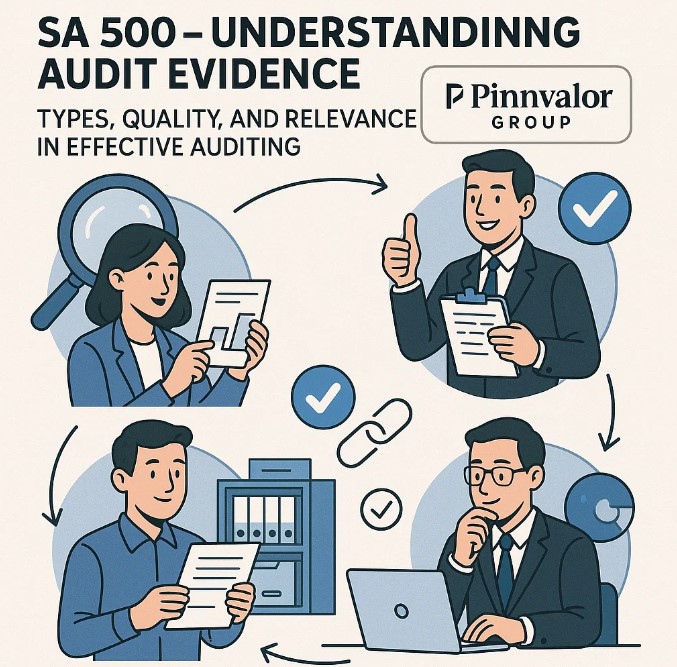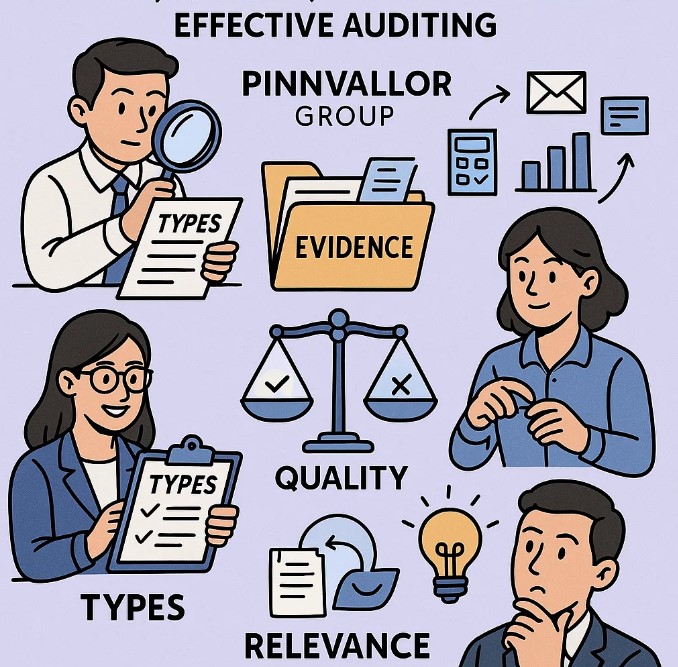
SA 500 – Understanding Audit Evidence: Types, Quality, and Relevance in Effective Auditing
In the world of auditing, the foundation of every audit opinion lies in the quality and reliability of audit evidence. The Standards on Auditing (SA) issued by the Institute of Chartered Accountants of India (ICAI) provide clear guidance on how audit evidence should be gathered and evaluated. Among these, SA 500 – Audit Evidence serves as the cornerstone in shaping audit judgments. This blog dives deep into SA 500, unpacking the types of audit evidence, its quality, relevance, and its critical role in forming audit conclusions.
Is your audit backed by evidence that truly speaks for itself?
When audit risks rise, so must the quality and quantity of your audit evidence. SA 500 reminds us that professional judgment, not just procedures, drives audit excellence.
What Is SA 500?
SA 500 – Audit Evidence defines the auditor’s responsibility to design and perform audit procedures to obtain sufficient and appropriate audit evidence to draw reasonable conclusions on which to base the audit opinion.
It highlights:
- The concept of audit evidence,
- The methods of obtaining evidence,
- And the factors that influence its quality and relevance.
Objectives of SA 500
The main objective of SA 500 is to ensure the auditor obtains audit evidence that is both sufficient and appropriate to reduce audit risk to an acceptably low level. The auditor must design procedures that collect reliable information supporting the financial statements’ assertions.
Key Concepts in Audit Evidence
1. Sufficiency vs. Appropriateness
- Sufficiency: Refers to the quantity of audit evidence. More evidence may be required when the risk of material misstatement is higher.
- Appropriateness: Refers to the quality of audit evidence, including its relevance and reliability in supporting the auditor’s conclusions.
2. Assertions in Financial Statements
Audit evidence is gathered to test management's assertions related to:
- Existence
- Rights and obligations
- Completeness
- Accuracy
- Valuation
- Presentation and disclosure
Types of Audit Evidence
Audit evidence can be classified into several types, depending on its source and nature:
1. Physical Evidence
Obtained through inspection or observation, such as verifying inventory by physical count. It is generally reliable when obtained directly by the auditor.
2. Documentary Evidence
Includes invoices, contracts, board minutes, etc. It can be:
- Internal evidence: Created within the organization.
- External evidence: Originates outside the entity, such as bank statements or supplier confirmations. Generally, external evidence is more reliable.
3. Oral Evidence
Information provided through enquiries and interviews. While useful, it is less reliable unless corroborated by documentary or physical evidence.
4. Analytical Evidence
Involves using ratios, trends, and comparisons to assess the consistency of financial data. It helps in identifying anomalies and areas needing further investigation.
5. Computational Evidence
Verification of calculations and arithmetical accuracy, often used in testing payroll, depreciation, or provisions.

Methods of Obtaining Audit Evidence
SA 500 outlines various procedures to collect audit evidence:
- Inspection: Examining records, documents, or tangible assets.
- Observation: Watching processes being performed, such as inventory counting.
- Inquiry: Seeking information from knowledgeable persons within or outside the entity.
- Confirmation: Obtaining a direct response from a third party, such as debtors or banks.
- Recalculation: Checking the mathematical accuracy of documents or records.
- Reperformance: Auditor’s independent execution of procedures or controls.
- Analytical Procedures: Evaluating financial information by studying plausible relationships.
Quality of Audit Evidence: Factors Influencing Reliability
Audit evidence varies in its reliability. According to SA 500, evidence is more reliable when it is:
- Obtained from independent sources outside the entity,
- Generated internally under effective internal controls,
- Obtained directly by the auditor,
- Documented, rather than oral,
- Original documents (as opposed to photocopies or faxes).
The auditor’s professional skepticism and judgment are critical in assessing the quality and sufficiency of the evidence gathered.
Relevance of Audit Evidence
Relevance is about how well the evidence supports a particular assertion or audit objective. For example:
- To verify existence of inventory, physical inspection is relevant.
- To test valuation of receivables, confirmation from debtors is more relevant.
Irrelevant or poorly aligned evidence can weaken the audit opinion, no matter how plentiful it is.
Documentation Requirements under SA 500
Auditors must document:
- The procedures performed,
- The evidence obtained,
- And the conclusions reached.
This documentation forms the audit trail and helps in review and quality control.
Conclusion
SA 500 emphasizes that a strong audit opinion is not built on quantity alone, but on quality, relevance, and professional judgment. As businesses become more complex and data-driven, auditors must ensure their approach to gathering audit evidence evolves accordingly—leveraging technology, enhancing analytical techniques, and adhering to auditing standards rigorously.
Whether you're an auditor, finance professional, or business owner, understanding the principles of SA 500 provides deeper insight into how trustworthy financial reporting is built and assured.
